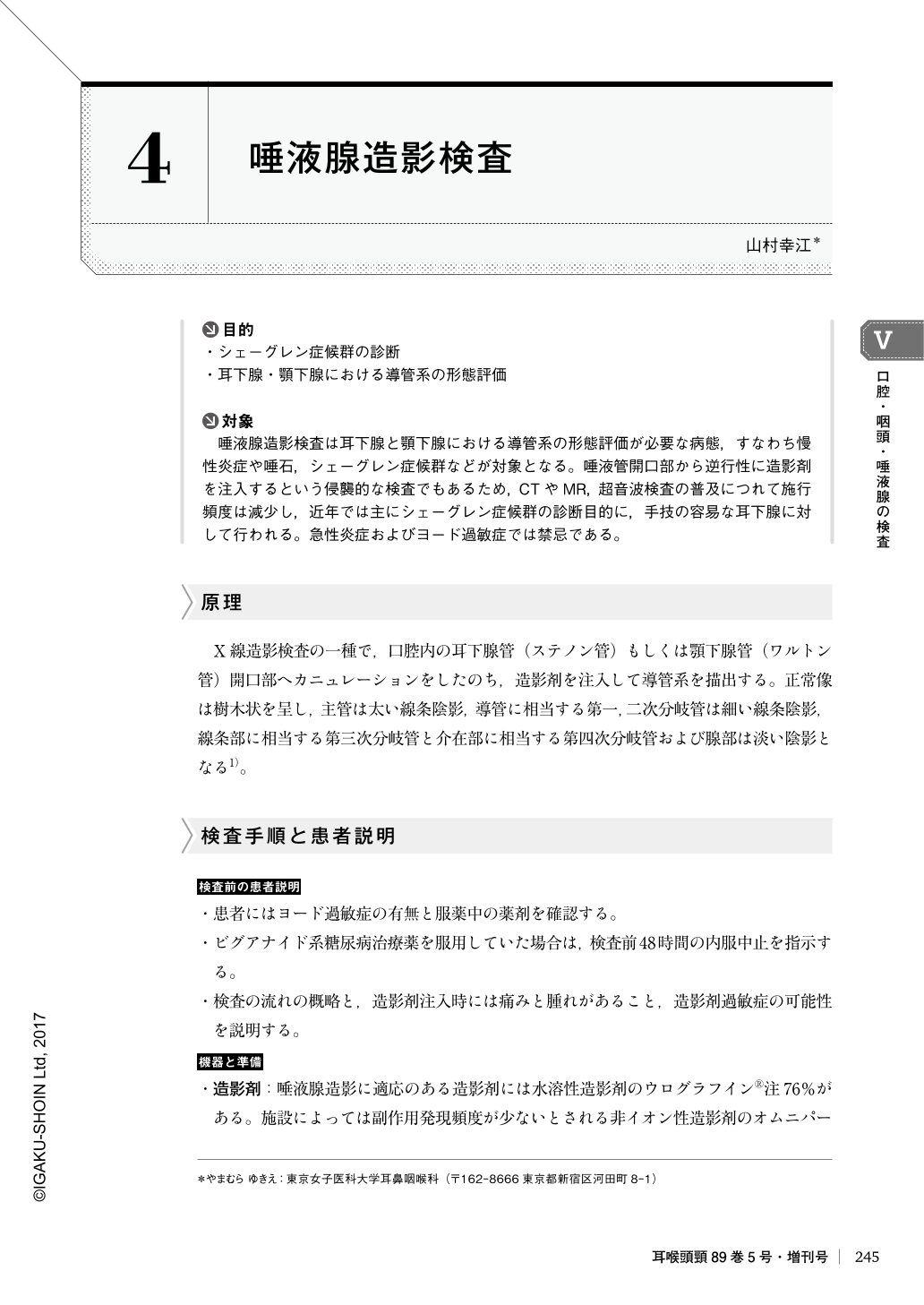4 0 0 0 OA ドライマウスの診かた
- 著者
- 山村 幸江
- 出版者
- 日本口腔・咽頭科学会
- 雑誌
- 口腔・咽頭科 (ISSN:09175105)
- 巻号頁・発行日
- vol.29, no.1, pp.91-98, 2016-03-31 (Released:2016-06-23)
- 参考文献数
- 20
- 被引用文献数
- 1
ドライマウス患者の多くは高齢者で, 唾液腺の加齢に服薬と咀嚼機能低下等が複合して関与する. 亜鉛欠乏も味覚障害のみならず口内痛や唾液量減少にも関わる. ドライマウスへの対応としてガムをかむなどの唾液分泌を刺激する習慣付けは有用である. 歯科的治療も咀嚼機能保持および齲歯と歯周病の予防・治療のために重要である. 内服薬では M3 ムスカリン作動薬は唾液腺機能が残存する場合は有効だが, 唾液腺以外のムスカリン受容体も刺激するため副作用による服薬中断例が少なくない. 副作用軽減の工夫として服用量を徐々に増やす漸増法, 同容量を多数回に分ける分割投与, 水溶させた薬剤をうがいに用いるリンス法, 飲料に混合する服用法がある.
1 0 0 0 OA 耳下腺腫瘍のRI診断
- 著者
- 山村 幸江 吉原 俊雄
- 出版者
- 日本口腔・咽頭科学会
- 雑誌
- 口腔・咽頭科 (ISSN:09175105)
- 巻号頁・発行日
- vol.22, no.1, pp.61-65, 2009 (Released:2010-06-01)
- 参考文献数
- 21
耳下腺腫瘍の診断におけるRI検査の有用性を検討した. 99mTcO4- シンチグラフィーはWarthin腫瘍とオンコサイトーマでは集積を示し, 診断の補助に有用である. 67Gaシンチグラフィーは耳下腺の高悪性度癌では一般に集積を示すが, 低悪性度癌での集積は半数程度であり, 良性腫瘍の多形腺腫やWarthin腫瘍にも集積する. 従って 67Gaシンチは主に高悪性度耳下腺癌の遠隔転移と再発の検索に有用である. 最近普及が進んでいるPETは, 悪性腫瘍の全身検索や再発の早期診断に有用であり, 67Gaシンチと比較して病変検出率は高い.
1 0 0 0 4 唾液腺造影検査
1 0 0 0 耳鼻咽喉科用内視鏡の洗浄法別の清浄度:―ATP法による評価―
- 著者
- 山村 幸江 草間 薫 吉原 俊雄
- 出版者
- 日本耳鼻咽喉科感染症・エアロゾル学会
- 雑誌
- 日本耳鼻咽喉科感染症・エアロゾル学会会誌 (ISSN:21880077)
- 巻号頁・発行日
- vol.5, no.1, pp.29-32, 2017
<p>Background: Flexible laryngeal endoscopes are important tools in the everyday practice of Ear-Nose-Throat (ENT) departments. However, reprocessing procedures for endoscopes without suction or instrument channels (i.e., observation-only scopes) have not yet been standardized in Japan. The reprocessing process of endoscope consists of cleaning, disinfection, rinse, and storage. As for cleaning, the guideline of United Kingdom recommends the scopes to be cleaned using running water and neutral enzymatic detergents. However in Japan, recent questionnaire surveys show that the majority of ENT departments clean the scopes without detergents.</p><p>Therefore, we performed an ATP bioluminescence test for hygiene monitoring of the scopes to confirm the necessity of detergents.</p><p>Materials and methods: In two ENT clinics, 30 laryngoscopes were cleaned using each different protocols as follows.</p><p>Clinic A:</p><p>i.Wipe the insertion parts with alcohol gauze.</p><p>ii.Scrub the insertion parts with a sponge soaked with a neutral detergent for kitchen use.</p><p>iii.Scrub the insertion parts with a sponge soaked with an enzymatic detergent for endoscopes.</p><p>Clinic B:</p><p>i.Soak insertion parts in running water for a few seconds.</p><p>ii.Scrub the insertion parts with a sponge soaked with a neutral detergent for kitchen use.</p><p>iii.Scrub the insertion parts with a sponge soaked with an enzymatic detergent for endoscopes.</p><p>After soaking these scopes in the disinfectant and rinsing them with water, the ATP test was performed using a 3M™ Clean-Trace™ Luminometer. The measured ATP was expressed in relative light units (RLU). The result is defined as "pass" when the measured RLU was 20 and below, "fail" when the RLU was 21 and above. The ratio of pass/fail was compared between the different cleaning protocols.</p><p>Results: The ratio of pass/fail was as follows.</p><p>Clinic A: alcohol gauze, 14/18 (pass: 43.8%), neutral detergent for kitchen use, 24/6 (80%), enzymatic detergent for endoscopes, 29/1 (96.6%).</p><p>Clinic B: Running water, 21/9 (70%), neutral detergent for kitchen use: 25/5 (83%), enzymatic detergent for endoscopes, less soaking time 19/11 (63.3%), enough soaking time 30/0 (100%).</p><p>Conclusion: ATP hygiene monitoring shows, that for cleaning of laryngeal endoscopes, it is necessary to use enzymatic detergents with sufficient soaking time. The detergent for kitchen use is inadequate for cleaning endoscopes.</p>
1 0 0 0 IR ある軍人婦人の引揚げ体験
- 著者
- 山村 幸
- 出版者
- 「満洲の記憶」研究会
- 雑誌
- 満洲の記憶 (ISSN:2189390X)
- 巻号頁・発行日
- vol.4, pp.14-24, 2017-10-31
執筆:山村幸整理:山田千里解題・編集:大野絢也、佐藤仁史
1 0 0 0 IR コンサートによる音響外傷
- 著者
- 山村 幸江 高山 幹子 石井 哲夫
- 出版者
- 東京女子医科大学学会
- 雑誌
- 東京女子医科大学雑誌 (ISSN:00409022)
- 巻号頁・発行日
- vol.62, no.6, pp.596-597, 1992-07-25
東京女子医科大学学会第291回例会 平成4年6月18日 消化器病センター2階カンファレンスルーム
